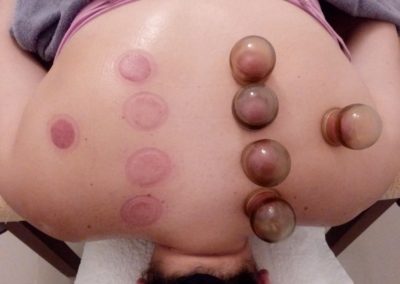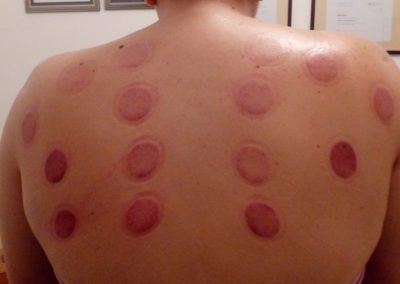MEDICAL TREATMENTS
CUPPING: (60 Min)
Cupping is a type of alternative therapy that originated in China. It involves placing cups on the skin to create suction. The suction may facilitate healing with blood flow.
Proponents also claim the suction helps facilitate the flow of “qi” in the body. Qi is a Chinese word meaning life force. A famous Taoist alchemist and herbalist, Ge Hong, reportedly first practiced cupping. He lived from A.D. 281 to 341.
Many Taoists believe that cupping helps balance yin and yang, or the negative and positive, within the body. Restoring balance between these two extremes is thought to help with the body’s resistance to pathogens as well as its ability to increase blood flow and reduce pain.
Cupping increases blood circulation to the area where the cups are placed. This may relieve muscle tension, which can improve overall blood flow and promote cell repair. It may also help form new connective tissues and create new blood vessels in the tissue.
People use cupping to complement their care for a host of issues and conditions.
Cupping therapy is an ancient form of alternative medicine in which a therapist puts special cups on your skin for a few minutes to create suction. People get it for many purposes, including to help with pain, inflammation, blood flow, relaxation and well-being, and as a type of deep-tissue massage. Cupping therapy might be trendy now, but it’s not new. It dates back to ancient Egyptian, Chinese, and Middle Eastern cultures. One of the oldest medical textbooks in the world, the Ebers Papyrus, describes how the ancient Egyptians used cupping therapy in 1,550 B.C.
Reflexiva Natural Healing Center is offering you the most professional, effective and trusted Cupping Treatment, studying your personal case and caring about your integral health.
This treatment consists of:
– Clinical History (1st Session)
– Cupping: Located in affected areas, depending on the ailment, it is commonly applied to muscular problems in the back, neck, shoulders, arms, legs, stomach.
After making the complete diagnosis and treatment, the patient is given the protocol to follow as the case may be.
– Continuous treatment in most cases should be performed at least 3 therapies
– Monitoring and control of treatment with weekly and gradually monthly therapies according to the patient’s evolution.
*Trusted Sourse: Healthline.com
What are the different types of cupping?
Cupping was originally performed using animal horns. Later, the “cups” were made from bamboo and then ceramic. The suction was primarily created through the use of heat. The cups were originally heated with fire and then applied to the skin. As they cooled, the cups drew the skin inside.
Modern cupping is often performed using glass cups that are rounded like balls and open on one end.
There are two main categories of cupping performed today:
- Dry cupping is a suction-only method.
- Wet cupping may involve both suction and controlled medicinal bleeding.
Your practitioner, your medical condition, and your preferences will help determine what method is used.
What should I expect during a cupping treatment?
During a cupping treatment, a cup is placed on the skin and then heated or suctioned onto the skin. The cup is often heated with fire using alcohol, herbs, or paper that’s placed directly into the cup. The fire source is removed, and the heated cup is placed with the open side directly on your skin.
Some modern cupping practitioners have shifted to using rubber pumps to create suction versus more traditional heat methods.
When the hot cup is placed on your skin, the air inside the cup cools and creates a vacuum that draws the skin and muscle upward into the cup. Your skin may turn red as the blood vessels respond to the change in pressure.
With dry cupping, the cup is set in place for a set time, usually between 5 and 10 minutes. With wet cupping, cups are usually only in place for a few minutes before the practitioner removes the cup and makes a small incision to draw blood.
After the cups are removed, the practitioner may cover the previously cupped areas with ointment and bandages. This helps prevent infection. Any mild bruising or other marks usually go away within 10 days of the session.
Cupping is sometimes performed along with acupuncture treatments. For best results, you may also want to fast or eat only light meals for two to three hours before your cupping session.
What conditions can cupping treat?
Cupping has been used to treat a wide variety of conditions. It may be particularly effective at easing conditions that create muscle aches and pains.
Since the cups can also be applied to major acupressure points, the practice is possibly effective at treating digestive issues, skin issues, and other conditions commonly treated with acupressure.
- Cupping is providing the following benefits:
- Decrease pain
- Decrease tenderness
- Improve mobility
- Improve tissue oxygenation
- Improve function
- In my practice, I find cupping most beneficial for treating back pain, neck pain, shoulder pain, hip pain, and knee pain.
- Cupping can be used to treat all kinds of orthopedic impairments.
What are the side effects of cupping therapy?
Cupping is fairly safe, as long as you go to a trained health professional. But you could have these side effects in the area where the cups touch your skin.
There aren’t many side effects associated with cupping. The side effects you may experience will typically occur during your treatment or immediately after.
You may feel lightheaded or dizzy during your treatment. You may also experience sweating or nausea.
After treatment, the skin around the rim of the cup may become irritated and marked in a circular pattern. You may also have pain at incision sites or feel lightheaded or dizzy shortly after your session.


